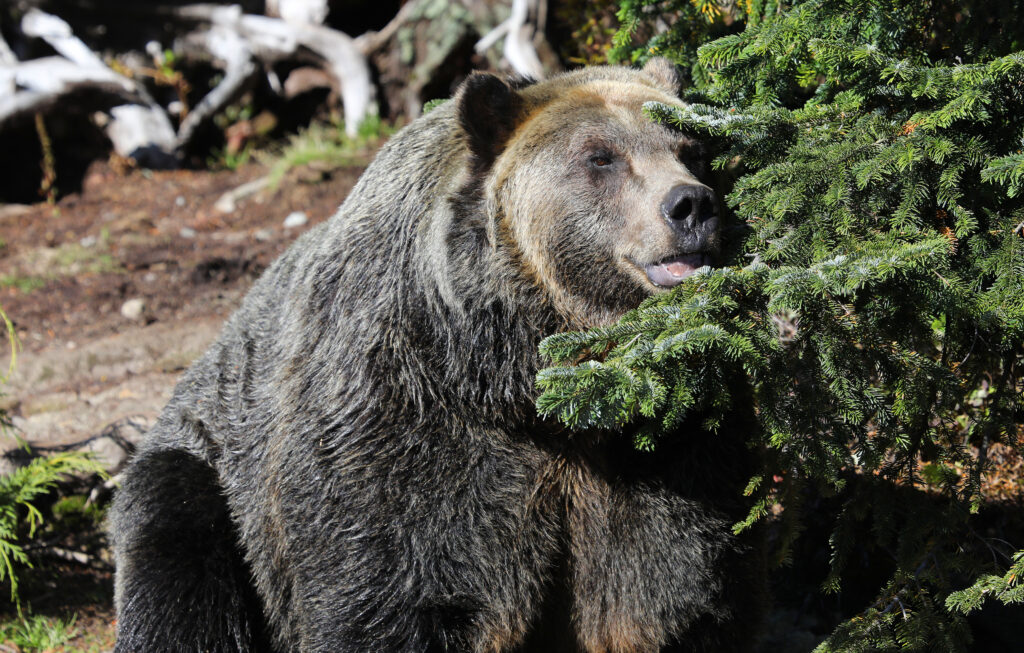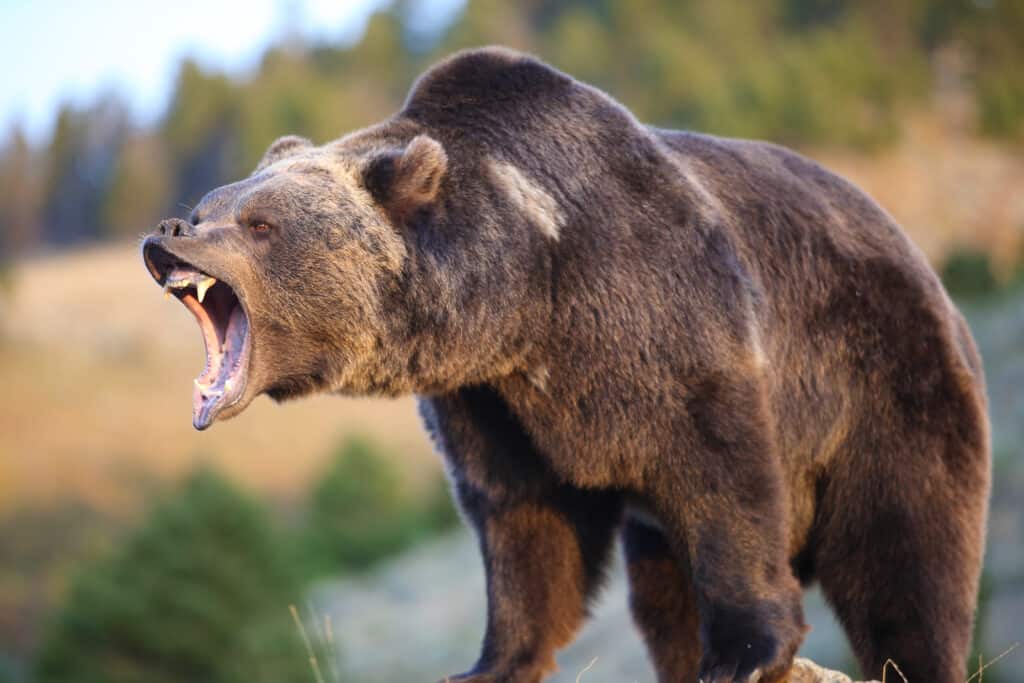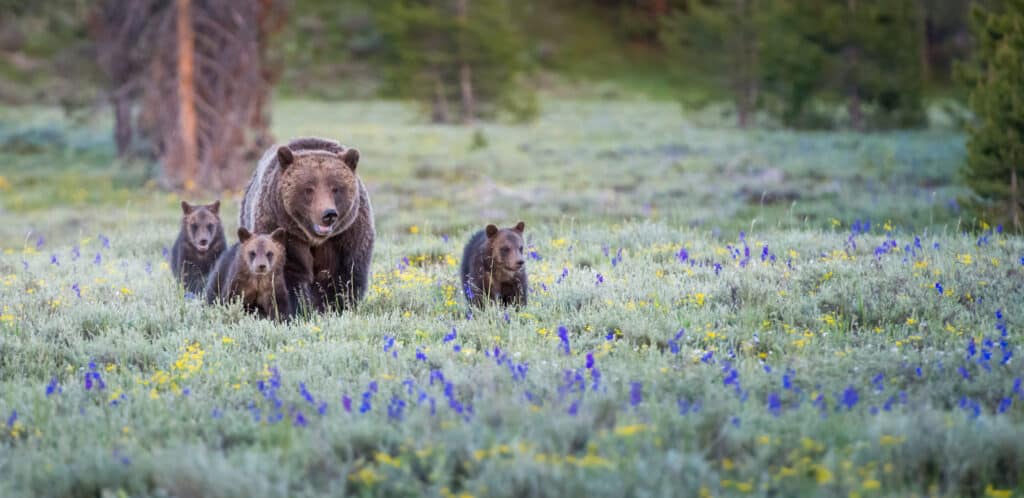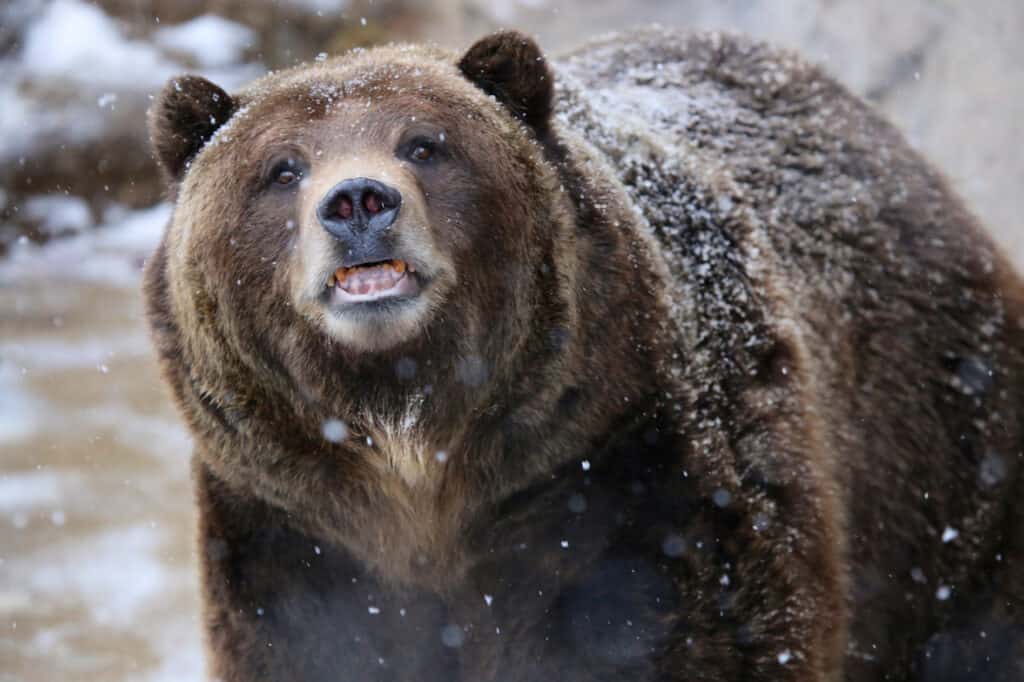Grizzly bears, known scientifically as Ursus arctos horribilis, are among the most wonderful creatures on the planet. In Montana State, they have a special place in the hearts of many residents and visitors.
These powerful and awe-inspiring mammals can be found in the state’s wild places. Their habitats range from the lush valleys and rolling prairies of the Great Plains to the high peaks of the Rocky Mountains.
Montana’s grizzly bear population has a long and complex history. Over the past century, the state has played a key role in conserving and managing these animals.
Today, we discover the largest grizzly bear trophy in Montana State’s records. We also delve into grizzly bears’ history, current status, interaction with humans, and role in Montana’s ecosystem.
The Largest Grizzly Bear Ever Caught In Montana

The largest grizzly bear ever caught in Montana (not pictured) was captured in 1890.
©Jacqui Martin/Shutterstock.com
Hunter E.S. Cameron caught the largest grizzly bear in the history of Montana in 1890. It scored an impressive 25 9/16 points. The National Museum of Natural History currently owns the trophy.
Its runner-up is a 25 7/16-point catch by Ted Johnson. Johnson caught the bear in 1934. E.C. Cates currently owns it.
The most recent grizzly bear catch in Montana is a 25-point trophy owned by Jack Stewart. The bear was picked up in 1976.

The Largest Grizzly Bear Ever Caught Worldwide
The world record for the largest grizzly bear ever caught is 1200 lbs. This weight was based on the size of the bear’s skull since it wasn’t alive when discovered. The skull was discovered in 1976 by a taxidermist. Its runner-up is one shot by a hunter in 2014. Its skull measured 27 6/16 inches long.
History of Grizzly Bears In Montana

Historically, grizzly bears have been abundant in Montana.
©Islandwave Photography/Shutterstock.com
Grizzly bears are native to North America and once roamed the continent from Alaska to Mexico and California to the Great Plains.
Historically, grizzly bears were abundant in Montana, with an estimated population of over 100,000 in the mid-19th century.
Historical Population Of Grizzly Bears In Montana
Montana’s historical grizzly bear populations have fluctuated over time due to various factors, including:
- Habitat loss
- Hunting
- Human development
In the early 1800s, fur traders and mountain men hunted grizzly bears for their valuable pelts. By the mid-1800s, the bears had been extirpated from much of their range in the United States, including most of the Great Plains.
In Montana, grizzly bear populations declined rapidly in the late 1800s and early 1900s. By the 1920s, grizzly bears had been nearly eliminated from the state, with only a few hundred remaining in isolated pockets of wilderness.
Factors That Led To The Decline Of Grizzly Bears In Montana
The decline of grizzly bears in Montana was primarily due to human activities. Habitat loss, caused by the conversion of natural habitats into farmland, logging, and mining, resulted in the fragmentation and isolation of grizzly bear populations.
Additionally, the unregulated hunting of grizzly bears for sport and fur played a significant role in their decline.
During the 20th century, the spread of human settlements and infrastructure such as roads and railways further fragmented and degraded grizzly bear habitat. This made it even more difficult for bears to move between different areas.
The isolation led to a genetic bottleneck in the grizzly bear population. This further reduced their genetic diversity and ability to adapt to changing environmental conditions.
Current Status Of Grizzly Bears In Montana

Montana hosts the largest grizzly bear population of the contiguous United States.
©Dennis W Donohue/Shutterstock.com
Grizzly bears are an iconic species of the American West. Montana is one of the most important strongholds for these magnificent creatures.
Current Population Of Grizzly Bears In Montana
Today, Montana hosts the largest grizzly bear population in the contiguous U.S., with an estimated 2,000 animals inhabiting the state’s wilderness areas.
Some of these bears reside in and around the Greater Yellowstone Ecosystem consisting of the following:
- Grand Teton National Park
- Yellowstone National Park
- Surrounding lands in Idaho, Wyoming, and Montana
The grizzly bear population in Montana has rebounded significantly since the early 20th century. This can largely be attributed to conservation efforts such as the Endangered Species Act. The Act listed the grizzly bear as a threatened species in 1975.
This designation protected grizzly bears and their habitats and allowed for the development of recovery plans to help rebuild populations.
Threats To Grizzly Bear Populations In Montana
Despite their current population numbers, grizzly bears in Montana continue to face many threats.
One of the biggest threats is habitat loss and fragmentation, as human development continues to encroach on wilderness areas. This can lead to increased human-bear conflicts, as bears are forced to move into areas where people live and work.
Other threats to grizzly bear populations in Montana include climate change and hunting. Climate change can alter habitat suitability and availability of food sources. While hunting is not allowed in the lower 48 states, it’s still a concern for bears that may roam outside protected areas.
Additionally, increasing recreation and tourism in areas such as Yellowstone National Park can negatively impact bears and their habitats, including:
- Increased human presence
- Habitat degradation
Efforts to Conserve and Protect Grizzly Bears in Montana
Numerous efforts are underway to conserve and protect grizzly bears in Montana.
One of the most important is managing bear habitats by establishing protected areas, including wilderness areas and national parks. These areas provide important habitats for bears to feed, breed, and raise young without human interference.
Another important effort is the management of human-bear conflicts through programs such as bear-resistant trash cans and electric fences. These measures help reduce the likelihood of bears coming into contact with humans. Consequently, they reduce the likelihood of human-bear conflicts.
Finally, research and monitoring programs are critical for understanding grizzly bear populations and their ecological roles. Programs such as the “Interagency Grizzly Bear Study Team” (IGBST) provide important data on bear populations, habitats, and behavior, which helps inform conservation efforts and recovery plans.
Interaction between Humans and Grizzly Bears in Montana

Human expansion into grizzly bear territory has caused a plethora of problems.
©iStock.com/Jillian Cooper
Grizzly bears are a keystone species in Montana’s ecosystem, but their presence in the state can sometimes lead to conflicts with humans.
Human-Bear Conflicts in Montana
As human populations continue to grow and expand into grizzly bear habitats in Montana, the likelihood of human-bear conflicts increases. These conflicts can arise when bears are attracted to human food sources, such as garbage cans and bird feeders. Moreover, they could result from people accidentally or intentionally encroaching on bear habitats.
Human-bear conflicts can have serious consequences for both humans and bears. In some cases, bears that become habituated to human food sources may become more aggressive and pose a danger to humans.
In other cases, humans may inadvertently harm or kill bears in self-defense or in an attempt to protect their property.
Efforts to Manage Human-Bear Conflicts
Various efforts are underway in Montana to manage human-bear conflicts and reduce the likelihood of negative interactions between humans and bears.
One of the most important of these efforts is the implementation of bear-resistant trash cans and other food storage measures, which help prevent bears from accessing human food sources and becoming habituated.
Education and outreach programs are also critical for informing people about how to coexist safely with grizzly bears in Montana. Programs such as the Bear Aware Campaign provide information on how to minimize the risk of human-bear conflicts, including how to:
- Store food and garbage properly
- Hike and camp safely in bear country
- Recognize and avoid confrontations with bears
Hunting and Grizzly Bear Management in Montana
Another important aspect of the interaction between humans and grizzly bears in Montana is hunting and bear management.
While hunting is not allowed in the lower 48 states, it remains a concern for bears that may roam outside protected areas. The Montana Fish, Wildlife, and Parks Department manages grizzly bear populations and implements measures to protect them from hunting and other forms of human-caused mortality.
In addition to hunting, the management of grizzly bear populations in Montana involves a range of strategies, including:
- Monitoring bear populations
- Mapping habitats
- Developing recovery plans to help rebuild populations in areas where they have been depleted
Role of Grizzly Bears in Montana’s Ecosystem

Grizzly bears play a major role in any ecosystem of which they’re a part.
©Steve Boice/Shutterstock.com
Grizzly bears are an essential component of Montana’s ecosystem. They play a crucial role in maintaining the health and diversity of the state’s wilderness areas. Here is a detailed account of the role of grizzly bears in Montana’s ecosystem:
Keystone Species
Grizzly bears are considered a keystone species in Montana’s ecosystem. That means they play a critical role in maintaining the balance and diversity of the natural environment.
They do this by preying on other animals, such as elk and bison. This helps to keep herbivore populations in check and prevent overgrazing of vegetation.
Grizzly bears also scavenge the carcasses of dead animals. This helps distribute nutrients and promote the growth of new plant life.
Seed Dispersal
Grizzly bears also play a critical role in the dispersal of plant seeds.
They consume large quantities of berries and other fruits that are often not fully digested and subsequently dispersed in their droppings. This helps spread plant species and promote new vegetation growth in different areas.
Ecosystem Engineering
Grizzly bears are considered ecosystem engineers, as their activities can significantly impact the physical structure and function of the environment.
For example, grizzly bears create wallows. These are depressions in the ground where the bears roll and dig, creating small pools of water and exposed soil. The wallows provide important habitats for a range of animals, including insects and amphibians, and promote the growth of certain plant species.
Indicator Species
Grizzly bears are also considered an indicator species. That’s because their presence and behavior can provide valuable information about the health and condition of the ecosystem.
By monitoring the populations and movements of grizzly bears in Montana, conservationists and researchers can gain insights into the state of the ecosystem and identify potential areas of concern or focus for conservation efforts.
Key Takeaways
The largest grizzly bear ever caught in Montana also ranks highly in the nation, pointing to the importance of Montana to grizzly bears. Grizzly bears have a long and complex history in Montana. Their continued presence in the state is essential to maintaining the health and diversity of the ecosystem. Unfortunately, grizzly bears continue to face threats despite their protected status and conservation efforts. They include habitat loss, human-bear conflicts, and climate change.
Efforts to conserve grizzly bears in Montana require a multi-faceted approach. It includes habitat preservation, scientific research, and effective management strategies to minimize conflicts between bears and humans. This includes education and outreach efforts to promote coexistence between humans and bears and the development of technologies and practices that can help reduce the likelihood of negative interactions.
Although grizzly bears’ future in Montana remains uncertain, there is hope that ongoing conservation efforts will help ensure their survival and coexistence with humans.
Where Is Montana Located On A Map?
Montana is located in the Mountain West region in the northwest of the United States. It shares a border with Idaho to the west, Wyoming to the south, North Dakota and South Dakota to the east, and the following Canadian provinces to the North: Alberta, British Columbia, and Saskatchewan.
The photo featured at the top of this post is © Jacqui Martin/Shutterstock.com
Thank you for reading! Have some feedback for us? Contact the AZ Animals editorial team.







